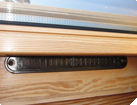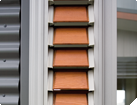- Home
- Site Analysis
- Site Use
- Passive Design
- Water
- Material Use
- Energy
- Wet Areas
- Health and Safety
- Other Resources
Passive Design
Designing the building and the spaces within it to benefit from natural light, ventilation and even temperatures.
Passive ventilation fixtures
There is a wide choice of fixtures and devices that allow effective passive ventilation in houses. Some can be left open even when the occupants are not at home, providing healthy ventilation without compromising security.
On this page:
- Openable windows
- Trickle ventilators
- Louvres.
Openable windows
Openable windows have always met the bulk of ventilation requirements in New Zealand houses. With appropriate selection and design they can still do that. There are many styles and methods of opening. These need careful consideration because they can have a significant effect on the volume of air changes provided:
- Casement windows (with hinges down one side of the frame) can catch prevailing winds or shield against them.
- Awning windows (with hinges along the top of the frame so the window opens at the bottom) can catch warm, rising air currents. They typically provide less ventilation than casement windows.
- Tall windows with open spaces at the top and bottom can allow cool air to enter at the bottom and warm air to be drawn out of the top.
- Narrow (100–150 mm wide) opening glass or cedar louvres/shutters incorporated into the window or door design allow ventilation while maintaining security.
Window location has a significant effect on the volume of air change produced. The most effective design is windows on opposite walls, but not directly facing each other. The next best option is windows on adjacent walls, with the least-preferred option being several ventilation openings on the same wall.
Designing approximately the same size of window openings on both walls is recommended for balanced ventilation. Where windows on different sides are different sizes, it will generally be preferable to have larger openable windows on the inlet (windward) side. Airflow speed is likely to be higher where inlet openings are small and outlet openings are larger and this may be undesirably draughty for occupants.
Trickle ventilators
Trickle ventilators are typically long, narrow controllable openings, often built along the top or bottom of a window frame, that provide ventilation as a result of air pressure differences. Positive air pressure on the windward side of a house pushes outside air in through the ventilators, while stale air is pushed out through ventilators on the leeward side. They are designed to prevent insect and rain entry.
A key advantage of trickle ventilators is security – they can be left open even when house occupants are away.
Trickle ventilators cannot be used to replace mechanical extract ventilation systems. On their own, they are not enough to manage high moisture loads, such as showering.
Trickle ventilators are included in Acceptable Solution G4/AS1. Requirements include:
- having an opening of no less than 2000 mm2 equivalent aerodynamic area
- being located to minimise draughts
- keeping pests and insects out
- being controllable and closable in all conditioned spaces
- having the equivalent aerodynamic area, based on the number of occupants, for the space as given in Tables 1 and 2 in the Acceptable Solution.
Under G4/AS1, high-level trickle ventilators are required in:
- houses where kitchens, bathrooms or laundries do not have an external wall
- habitable spaces that have an external wall and are open to a kitchen, bathroom, toilet or laundry with a passive stack ventilator
- habitable spaces that have an external wall and no opening to a kitchen, bathroom, toilet or laundry with a passive stack ventilator
- habitable spaces with both one external wall and a permanent opening to a kitchen, bathroom, toilet or laundry, within which a continuous mechanical extract system is installed
- habitable spaces with one external wall and a permanent opening to a kitchen, bathroom, laundry or toilet, within which an intermittent mechanical extract system is installed.
Habitable spaces without openings to the exterior that are ventilated via another habitable space must have both high-level and low-level trickle ventilators.
Louvres
Louvres are frames containing a series of parallel horizontal blades, usually glass (but sometimes another material such as cedar), set in metal holders. They may be fixed open, but are more likely able to be opened and closed to allow air to pass through in a controlled way. They may replace windows in certain locations. Louvres can allow more airflow than conventional window designs where the sash only opens a small way. The blades can be tilted so the louvres can be left open even in light rain.
A number of proprietary window louvres are available in New Zealand. Some can be opened or closed by a remote control or a building management system.
Openable louvres should meet the requirements of NZS 4211:2008 Specfication for performance of windows. They can be tested against AS/NZS 4740:2000 Natural ventilators – Classification and performance. Louvres are not covered in G4/AS1.
Louvres are more appropriate in warmer climates such as Northland, Auckland and the Bay of Plenty where they can be left at least partly open for much of the year.
Wide louvres are not recommended for buildings in very high or extra high wind zones. Installing wide proprietary louvres in these situations may void the warranty.
Louvres with glass or timber blades can also be installed on internal walls to allow natural airflow between rooms. Grilles or louvres can also be incorporated into doors to facilitate airflow through the building.
Updated: 27 May 2019



